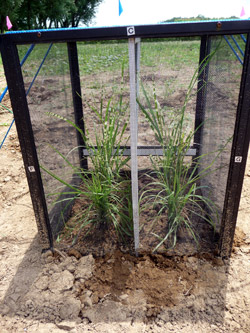– January 8, 2013
Last summer I started my grasses/grasshoppers feeding experiments in the field. The main problem I had to solve was building the cages.
The cages had to be high enough to accommodate the plants. They also had to be low enough so that I wouldn’t lose my grasshoppers there. I also needed some sort of a separator to divide the cage into two halves – for control plants and plants with grasshoppers. From literature, I knew that the cage should be metal, so that grasshoppers won’t chew through it and escape. Also, there should be screen walls – to let enough light into the cage (both for plants and grasshoppers).
After some searching I ended up using open air aluminum screen cages (16×16×20″ Repti Breeze Aluminum Screen Cage, Zoo Med Laboratories, Inc., California, USA). These cages are meant for keeping reptiles, but their material, size, and shape were exactly what I needed.
First I removed the bottom of the cage (it is just a plastic plate).


For a separator I used a small regular window screen – you can find those in Lowe’s or Home Depot, they are cheap. You can assemble your own, but I found one that was the perfect size for my cages. On both sides of the separator I attached a thick window sealant strip – so that it fit tightly against the screen walls of the cage and did not leave any holes for grasshoppers to move across the cage and feed on control plants – and ruin my data.

I placed some extra soil inside the cages to cover all possible holes at the bottom. It is a good idea to add even more soil than is needed: if it rains part of the soil will get washed out, uncovering new holes. I also added more soil outside along the edges of the cages.

I started my experiments by placing two different grass species in each half of the cage, but this year I will be planting four different grasses – I expect them to fit (UPDATE: they did fit perfectly!) I would not go with more than four though…

These are field experiments – so fixing cages to the ground is another problem. I used two ropes and four metal hooks; this proved to be very stable, even during heavy rain and strong wind.

The cages turned out to be very convenient not only for field experiments but also for a temporarily keeping grasshoppers in the lab (I usually keep them in the greenhouse). The cages have two doors, and the lowest one is designed specifically for cleaning the cage without disturbing the reptiles – that works for grasshoppers, too! I also often use this door for placing new grasshoppers in the cage; they tend to jump up when released in the cage from a collecting bag and this way they will not escape.
I hope this might be useful to someone who conducts similar experiments.
